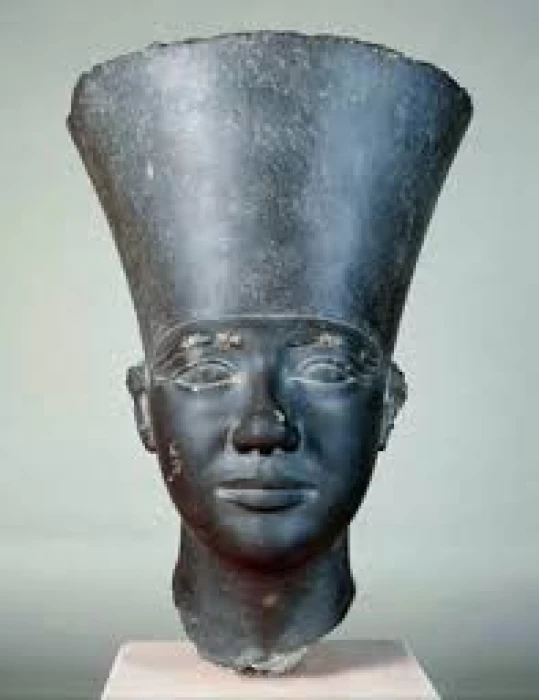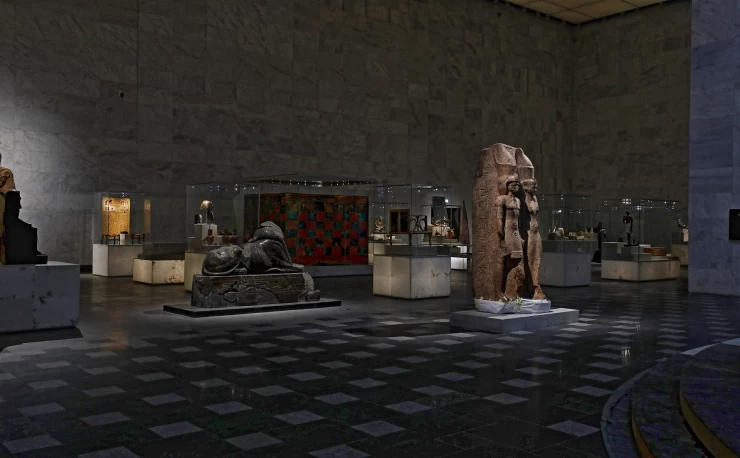
King Userkaf
King Userkaf
During his reign, the influence of the priesthood of Heliopolis and the solar cult of Amun had their main center in that city. Proof of this was the erection of the first solar temple, in Abu Ghurab, a structure that would become usual throughout the 5th dynasty; of the temple, known as the Court of the offerings of Ra, only a few traces remain: however, one of his titles in a palette was found, among the masterpieces of the art of the time.
Userkaf's reign might have witnessed a recrudescence of trade between Egypt and its Mediterranean neighbors thanks to a series of marine expeditions, which are represented in his mortuary temple. His mortuary temple was more complex than the common pattern and richly decorated, with a colossal statue of the king. It is unusual to have its mortuary temple to the south, not facing the River Nile.
He built a pyramid close to the Step Pyramid of Djoser at Saqqara. His pyramid is called (El Haram el Mekharbesh)or (the Ruined Pyramid). His Pyramid appears as a block of rubble. Today we can see its basalt door opened. Userkaf wanted to be close to Djoser's step pyramid and this location is probably for political and dynastic reasons, that's why he erected his Pyramid far from the cemetery of his ancestors at Abu Sir.
A larger complex of funerary structures, including a funerary temple, a chapel, a smaller pyramid dedicated to the pharaoh, and another pyramid and funerary temple for Userkaf's wife, Queen Neferhetepes, surrounds the larger pyramid.
King Userkaf, With his partner Neferhetepes, he had at least one daughter and most likely a son named Sahure. He was succeeded as king by this son.
Latest Articles
Admin
Seabourn Sojourn Cruise Stops in Safaga Port
The Seabourn Sojourn, the flagship vessel of Seabourn Cruise Line's ultra-luxury fleet, was built in 2008 at the T. Mariotti shipyard in Genoa, Italy. Measuring 198 metres, it can accommodate up to 450 guests in its 225 spacious all-suite staterooms.
Admin
Norwegian Sky Cruise Stops in Safaga Port
Norwegian Cruise Line operates a cruise ship called the Norwegian Sky. It was constructed in 1999 and can accommodate 2,004 passengers in addition to 878 crew members. The ship has several dining establishments, lounges and bars, a spa and fitness center, swimming pools, and a number of entertainment areas.
Admin
Explora II Cruise Stops in Safaga Port
Explora II, the second vessel in the Explora Journeys fleet, sets sail in 2024 to redefine luxury cruising. With 461 ocean-front suites, 9 culinary experiences, and 4 pools, this haven of sophistication and sustainability promises an unforgettable "Ocean State of Mind" journey to inspiring destinations.
Admin
Mein Schiff 6 Cruise Stops in Safaga Port
The Mein Schiff 6 is the latest cruise ship in the renowned TUI Cruises fleet, offering passengers a luxurious and sophisticated cruise experience. At 315 metres long, this floating resort features a range of dining options, entertainment, and recreational facilities, including a spa, fitness centre, and sports amenities.
Admin
Mein Schiff 4 Cruise Stops in Safaga Port
When the Mein Schiff 4 cruise ship docks in Safaga, Egypt, passengers are granted access to a realm of ancient wonders. Aboard this state-of-the-art vessel, guests can embark on meticulously curated shore excursions that showcase the region's most iconic landmarks, including the Giza Pyramids, the enigmatic Sphinx, and the remarkable tombs and temples of the Valley of the Kings in Luxor.
Admin
MS Europa Cruise Stops in Safaga Port
The Silver Moon, Silversea's latest flagship, is a luxury cruise ship that offers an exceptional travel experience for Venezuelans exploring Egypt. With a capacity of 596 guests and an impressive 40,700 gross tonnes, the Silver Moon maintains the small-ship intimacy and spacious all-suite accommodations that are the hallmarks of the Silversea brand.














